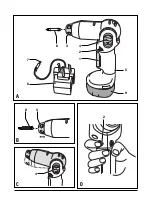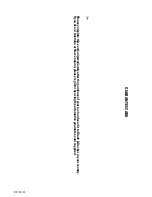
4
◆
Under extreme conditions, battery leakage may occur.
When you notice liquid on the battery, proceed as follows:
- Carefully wipe the liquid off using a cloth. Avoid skin
contact.
- In case of skin or eye contact, follow the instructions
below.
Warning!
The battery fluid, a 25-30% solution of potassium
hydroxide, can be harmful. In case of skin contact, immediately
rinse with water. Neutralise with a mild acid such as lemon
juice or vinegar. In case of eye contact, rinse abundantly with
clean water for at least 10 minutes. Consult a physician.
◆
Do not incinerate the battery.
◆
Do not attempt to charge damaged batteries.
Chargers
◆
Use your Black & Decker charger only to charge the battery
in the tool with which it was supplied. Other batteries
could burst, causing personal injury and damage.
◆
Never attempt to charge non-rechargeable batteries.
◆
Have defective cords replaced immediately.
◆
Do not expose the charger to water.
◆
Do not open the charger.
◆
Do not probe the charger.
The charger is intended for indoor use only.
Electrical safety
Your charger is double insulated; therefore no earth
wire is required. Always check that the mains
voltage corresponds to the voltage on the rating
plate. Never attempt to replace the charger unit with
a regular mains plug.
Overview (fig. A)
1. Variable speed switch
2. Forward/reverse slider
3. Bit holder sleeve
4. Head adjustment button
5. Charger connector
6. Charger
7. Charger plug
8. Screwdriver bit
9. Battery cover
Assembly
Fitting and removing a drill bit or screwdriver bit
(fig. B & D)
This tool uses screwdriver bits and drill bits with a 1/4"
(6.35) mm hexagonal shank.
◆
Lock the tool by setting the forward/reverse slider (2) to
the centre position (fig. D).
◆
Pull back the bit holder sleeve (3) (fig. B).
◆
Insert the bit shaft (8) into the bit holder.
◆
Release the bit holder sleeve.
Use
Warning!
Before drilling into walls, floors or ceilings,
check for the location of wiring and pipes.
Charging the battery (fig. A)
The battery needs to be charged before first use and whenever
it fails to produce sufficient power on jobs that were easily
done before. A new battery or a battery that has not been
used for a long period of time achieves full performance only
after approximately 5 charging and discharging cycles.
After normal use, a charging time of 3 hours will enable the
tool to operate at an effective power level for most tasks.
However, further charging for up to 6 hours could significantly
increase the run time, depending on the battery and charging
conditions. The battery may become warm while charging;
this is normal and does not indicate a problem.
Warning!
Do not charge the battery at ambient temperatures
below 4
°
C or above 40
°
C. Recommended charging
temperature: approx. 24
°
C.
◆
To charge the battery, insert the charger plug (7) into the
connector (5).
◆
Plug in the charger. Switch on at the mains.
◆
Leave the tool connected to the charger for 3-6 hours.
The charger may hum and become warm while charging; this
is normal and does not indicate a problem.
◆
Before using the tool, unplug the charger and disconnect
the tool from the charger.
Warning!
Do not use the tool while it is connected to the charger.
Adjusting the head (fig. C)
For optimum versatility, the head can be set to different positions.
◆
Press the head adjustment button (4) down.
◆
Swivel the head into the desired position.
◆
Release the button.
Selecting the direction of rotation (fig. D)
For drilling and for tightening screws, use forward (clockwise)
rotation. For loosening screws or removing a jammed drill bit,
use reverse (counterclockwise) rotation.
◆
To select forward rotation, push the forward/reverse
slider (2) to the left.
Содержание screwdriver
Страница 1: ...1 UK Ireland Australia New Zealand ...
Страница 2: ...2 D C B A 2 4 1 3 8 6 7 5 9 3 8 4 2 ...


























